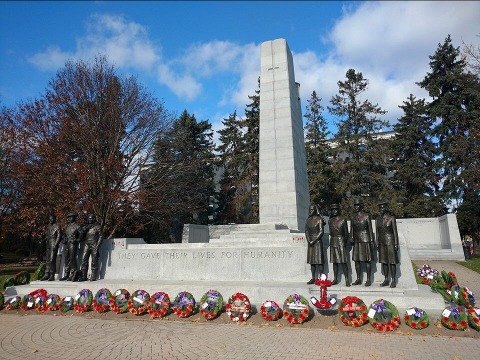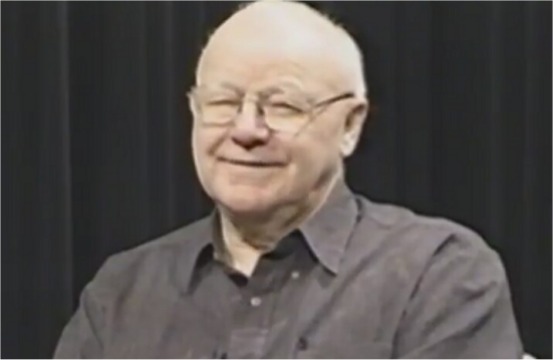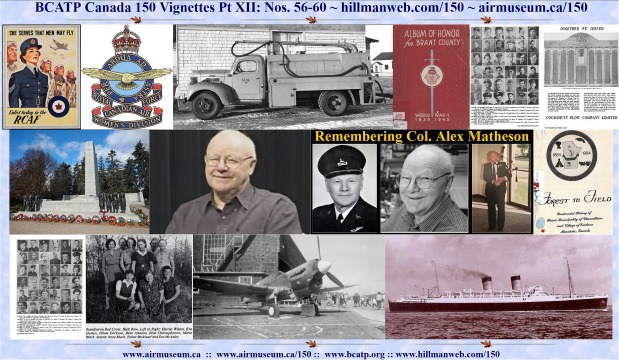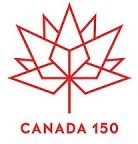Alex Matheson was a long-time volunteer at the
Commonwealth Air Training Plan Museum. He was well respected and liked
for his easy going manner and true interest in people with who he interacted.
In 2001, Alex sat in on a CATP Museum Oral History video interview conducted
by the museum’s Kathy Sheppard in her first job with us as Oral History
Facilitator. In the hour long interview, Alex, with the help of Kathy presents
a comprehensive and interesting explanation, with a dash or two of humour,
of training for an airman new to the British Commonwealth Air Training
Plan. This included the first stop in the RCAF – the Manning Depot – to
the last – graduation and the wings ceremony as airman eligible for operational
training. View this truly enjoyable hour on YouTube at:.
https://www.youtube.com/watch?v=qYGM9fDZuWg&t=25s
Alex died at the age of 91 years on May 16, 2016. He was
member of the Canadian Armed Forces for 33 years first enlisting in the
Royal Canadian Air Force in July 1943. He completed his BCATP training
as a pilot, but due to his graduation coming close to the end of World
War II, he did not see action in an operational unit. He transferred to
the army and built a career as an officer in the Royal Canadian Dragoons,
an Armoured Corps Regiment. His military career took him to various locations
in Canada as well as Korea, Cyprus, Laos and South Vietnam. He retired
in 1975 as a Colonel and Commanding Officer of CFB Shilo.
In retirement from the armed forces, he became an art
illustrator at Assiniboine Community College in Brandon where he eventually
became President of the school. Alex was active in many community groups
in Brandon such as President of the 1979 Canada Winter Games, the Brandon
Rotary Club, Royal Canadian Legion and CATP Museum where he was a frequent
Master of Ceremonies and also, the artist for over 60 issues of our CONTACT
newsletter. Alex is survived by his wife Peggy and four sons.
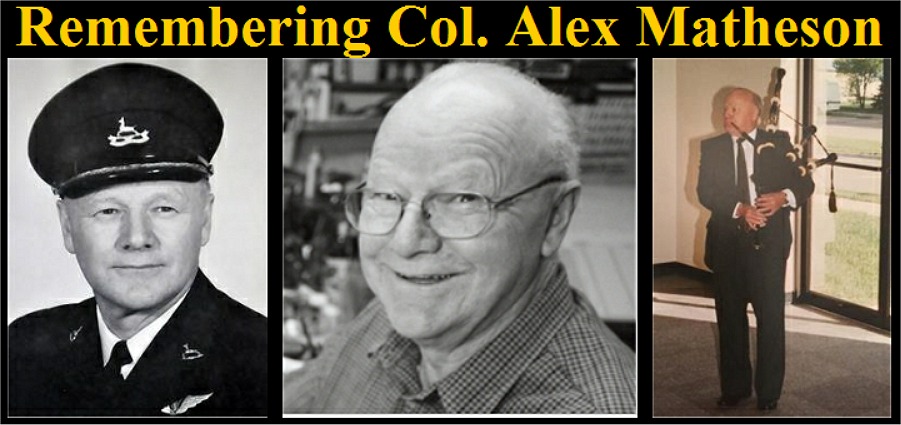
Reference: Bill
Hillman's AS YOU WERE . . . Military Tribute Webzine: May 2017
059 of
150: The Home Front - Clanwilliam Manitoba
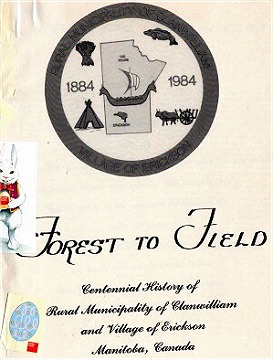
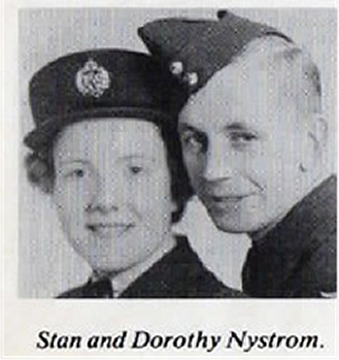 During World War II, hundreds of home-front groups were
formed to provide aid and comfort to those who were in the armed forces
or were refugees in foreign countries. Many groups were local volunteer
groups for larger organizations like the Royal Canadian Legion and the
Canadian Red Cross, The organizations provided guidelines and goals in
how each of the small committees could help. With men away from the community
in the army, navy or airi force, their numbers were considerably less than
the female population in each community. As such, women did the lion’s
share of work in groups raising funds and making clothing items and providing
a much needed boost to morale in their communities where all were concerned
about the welfare of others fighting in far off places. For the woman,
the work provided plenty of positive social contact and something to take
their minds off of the woes of the world.
During World War II, hundreds of home-front groups were
formed to provide aid and comfort to those who were in the armed forces
or were refugees in foreign countries. Many groups were local volunteer
groups for larger organizations like the Royal Canadian Legion and the
Canadian Red Cross, The organizations provided guidelines and goals in
how each of the small committees could help. With men away from the community
in the army, navy or airi force, their numbers were considerably less than
the female population in each community. As such, women did the lion’s
share of work in groups raising funds and making clothing items and providing
a much needed boost to morale in their communities where all were concerned
about the welfare of others fighting in far off places. For the woman,
the work provided plenty of positive social contact and something to take
their minds off of the woes of the world.
The Legion became a valuable resource for returning
veterans by offering good advice and information of their options back
in civilian life, especially by helping them access government readjustemnt
programs.
Our dedicated Commonwealth Air Training Plan Museum
volunteer Judith Grierson – Treasurer and Adjutant – brought to the museum
her copy of the Centennial History of the Rural Municipality of Clanwilliam
and Village of Erickson, produced in 1984 as a book thoroughly outlining
all things historical happening in that place in its hundred years. Volunteers
scoured the municipality for family histories, photo albums, institutional
records, newspaper articles etc. to be collated into this book for the
edification of residents. Of particular interest to us were the entries
relating to home front activities of World War II. We have taken excerpts
from the book explaining how local organizations were created and undertook
making the world a better place during World War II, It is an amazing example
of what this tiny municipality (population 1631 in 1941) achieved for the
war effort. The Rural Municipality and Village of Erickson within in borders
is about 50 miles north of Brandon Manitoba. This story is even more incredible
when one thinks to multiply the results of this place, many times to represent
the efforts of other every village, town and rural area across Canaada
– that’s a lot of sock and quilts.
We provide to you, a summary of the reported activities
of the Battle of the Canadian Home Front as it occurred in Clanwilliam
during World War II in addition to supplying 205 men and women to the Canadian
Armed Forces of which 20 became casualties.
ROYAL CANADIAN LEGION, ERICKSON BRANCH NO. 143
History by Jocelyne Steele
The Canadian Legion Erickson Branch of the British Empire
Service League, was formed in 1939, and received their Charter on June
29th of that year... Membership fees were $2.00 then and per capita tax
was .45¢. On Friday October 27th the first joint meeting with the
Ladies Auxiliary was held, with the ladies providing lunch… Donations were
made to the Red Cross to buy blankets, and to an ambulance fund, also to
the local restroom.
On November 11th, 1940, members of the Legion of the Erickson
district held their first church parade to the Lutheran church. Visitors
were present from Crawford Park, Wasagaming, Onanole, Sandy Lake, Rackham,
Hilltop, Scandinavia, Clanwilliam, Rapid City and Minnedosa. About one
hundred persons, Legion members and their wives marched in body from the
hall to the church, where Rev. Richard Odelberg took charge of the service.
During the war years. barn dances, teas, picnics etc. were held to supply
money to buy articles for boxes for the boys overseas, ably assisted by
the Ladies Auxiliary.
In 1941, a Remembrance Day Service was held by Rev. Thomas
Payne. Christmas parcels were sent to service men. The rent paid for dances
held in Scandia Hall was $6.00.
The first correspondence in regard to rehabilitation of
returned men was received in 1 942. The first appeals for help for ex-servicemen
came from Comrades Allen Roy Sigurdson and Archie Canada. A motion was
made that any members who owned a Legion badge and cap and not wearing
them at meetings would be fined .05¢, the money to be used to buy
cigarettes for the boys overseas
In 1943, Lloyd Hemmingson joined the branch, the first
veteran of World War 2 to do so. Pilot Officer Fred Wickstrom, Pte. Mike
Kozak, Pte. W.E. O'Brien, and Sgt. 0. Haralson were reported killed in
action.
In 1944 some veterans were coming home and the Legion
helped them get re-established in civilian life. In 1944, seventeen new
members joined the Legion.
On August 14, 1945, citizens of Erickson and District
turned out in masses to the "Welcome Home" social held in the community
hall in honor of fifty local servicemen recently returned to the district.
Mr. E. L. Johnson, President of the Erickson Rehabilitation Committee assisted
by Mrs. R.J. McKenzie and Mrs. Val Bizco presented each of the guests of
honor with a small token of appreciation from the community. The "Welcome
Home" address was delivered by Dr. E.J. Rutledge, MLA (Member of Manitoba
Legislative Assembly). Since the social fell on V.J. Day, a monster bonfire
was built on the street close to the hall and following lunch the party
gathered around the blazing fire. The evening concluded with a dance with
music provided by Mutter's Melody Makers.
On October 14, 1945, guests of honour at Erickson's Second
Welcome Home, 41 veterans met in the Lutheran Church, where they were presented
with monogrammed wallets and welcome home certificates. Addresses were
heard from Dr. Rutledge and Rev. C. Sevig. Again on December 26, 1945,
a welcome home in the form of a whist drive and dance was held for 50 more
returned personnel who received wallets and certificates. R.J. McKenzie
gave the address of welcome and made the presentations assisted by Mrs.
Val Bizco and Mrs. L.
Miller.
In 1946 the members started discussing the building of
a Legion Hall. It was decided to get a permit from Riding Mountain National
Park to take out 12,000 feet of lumber, at a cost of $15,000 per 1,000
feet. This was done but the lumber was later sold to members W.T. Turner,
J. Cutter (J.C. Farm Machine) and to the Elphinstone Legion… A decision
was made to look into buying the Hostel from the Park, at a cost of $300.00.
The hostel was officially opened June 15th, 1943, and for three summers
it was used by service men and women from many Allied countries. Legion
and Auxiliary members from Crawford Park, Onanole and Erickson were hosts
and hostesses there. The main part of the building was moved on to the
property on Main Street, purchased by the Branch. Mrs. O'Neill of Onanole
bought one wing and Mr. Doan the other. Comrades W. Miller and P. Vaughan
loaned the Branch the money to buy the building, the cheque was sent to
War Services March 22nd, and the loan was paid back in 1947. The building
was moved by Gordon Hedges, men who worked on getting it ready for use
included H. Frederickson, E. Eblin, Gust Bergstrom, O. Olson, Chris Olson,
Roy Johnson, who hauled sand and gravel and Jack Hicks who did the wiring.
The Ladies Auxiliary gave $ 100.00 toward the expenses. The official opening
was held June 17, 1 947.
The men served lunch for the Ladies one evening, which
has been continued each year since, at the February meeting.
In 1975, the 50th anniversary of the Legion, twenty five
hundred tulips were ordered from Holland, the branch gave some to Parkland
Home, members and people in the area bought the rest. All First World War
members were given Life Memberships,.. A gift of tulips was received from
the people of Holland to those veterans who took part in the liberation
of their country…
The Erickson Branch No. 143 of the Royal Canadian Legion
has a proud record in service to their comrades who need help and to the
community...
The support received from the people of Erickson and the
surrounding area, in all their endeavors has been the secret of their success.
And, as with all Legion branches, they give a great deal of credit to their
Ladies Auxiliary. It is hoped all their friends and supporters will soon
be helping them celebrate the burning of the mortgage.
ROYAL CANADIAN LEGION LADIES AUXILIARY NO. 143
by Harriet Hodges
Mrs. William Taylor arranged a meeting to be held in
the Municipal Hall in Erickson, the purpose, to organize an Auxiliary to
the Erickson Branch of the Legion, on Friday October 27, 1939. The meeting
was a success, and on December 11, 1939, they were granted a Charter. The
Charter members were:… The meetings were held in the Municipal Hall, and
they decided to hold them on Friday nights, the same as the men. The initiation
was held on January 6, 1940. The per capita tax was twenty-five cents per
member per year, but a few years later it was raised to ten cents per member
per meeting, and had to be sent in quarterly. In 1954 they changed it,
to having the per capita sent to Winnipeg annually. This amounted to dues
being $1.20 per year, an amount that was raised to two dollars a year in
Erickson in 1982.
This was during the war, so the members were dedicated
to working, for the services. They worked in conjunction with the Red Cross,
knitting and sewing. They also wrote letters to the men overseas, and at
Christmas time sent them parcels. On June 28, 1940 they voted a donation
of fifty dollars to the Minnedosa Ambulance. As there were already women
who had lost their husbands in the war, the Auxiliary worked to see that
they got an adequate pension, to provide for their children. On January
27, 1940 they had a Birthday supper at Brekke's Restaurant… The Dime Raffle
was started in December 30, 1943, the article to cost no more than 35 cents.
Mrs. Amanda Holmlund brought the first article, and it was won by Mrs.
Grodeski, and netted the sum of two dollars. They had many ways of raising
money, such as Silver teas, Galloping teas, Diminishing teas, travelling
aprons, travelling grocery baskets, selling homemade lemonade at the Legion
dances, Corn roasts at Ditch Lake at which they charged fifteen cents per
person and realized the sum of $5.00. They held Social evenings, and at
their meetings they had a jar that everyone dropped their pennies into.
The members were fined five cents, if they came to the meeting not wearing
their Legion beret. The ladies donated flour sacks, that were made into
quilts, and raffled. At the Social evenings and teas, Mrs. Ina Burkett
would read tea cups for a small charge. On May 3, 1947, and again in 1954
the Auxiliary sponsored a bingo. During the war years the members worked
at the Mobile Kitchen and Rest Unit at Riding Mountain National Park, for
the Service Personnel. The first Poppy Day Tea was held on November, 1942.
They sponsored dances and Masquerades in the Scandia Hall, which they rented
for the sum of seven dollars a night. They served lunch at the first Memorial
Service that was held on November 10, 1940. During the years of rationing,
each member was allowed only one cup of coffee for lunch. That began in
1942. A Tea was held in Newpert's Tea Room. They sold hot dogs, and the
sum of $ 16.90 was realized, the expenses were $3.95. They ordered twenty-four
Auxiliary hats, complete with badges, at a price of $1.50 each. In January
1946 it was decided to change the meeting day, from Friday to Tuesday evening.
The first Legion Hall was the Legion unit from the Riding Mountain National
Park, and it was moved to Main Street in Erickson. The first meeting held
in it was June 3, 1947. Deer Lodge Christmas Tree Fund began in December,
1947. Charging a silver collection for the lunch at the meeting began on
June 7, 1949, money to be used for a Flower and Fruit fund… In December
they adopted their first veteran in Deer Lodge Hospital, a Mr. John Morgan.
He was sent gifts on his birthday, and at Christmas and the members wrote
letters to him, Veterans adopted in later years were Mr. Bujarna, and Mr.
H. Pridden…
SCANDINAVIA RED CROSS
April 20th, 1916
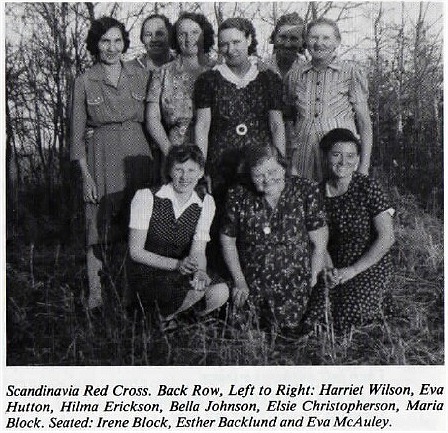 During the winter months the ladies of the Red Cross Society
of Scandinavia were not idle, but had accomplished a fair amount of work.
Goods had been handed out to different homes and returned completed to
the President, Mrs. E. Waterton. They had been made up by the following:
Mrs. R. Naslund, Mrs. Hodgson, Mrs. E. Hemmingson, Mrs. Fletcher, Agda,
Mabel and Mrs. P. Johnson, Mrs. Kalberg and Ellen. Miss Helge Hemmingson
was the secretary. Fifty Christmas stockings were made up by Scandinavia,
Hilltop and Danvers.
During the winter months the ladies of the Red Cross Society
of Scandinavia were not idle, but had accomplished a fair amount of work.
Goods had been handed out to different homes and returned completed to
the President, Mrs. E. Waterton. They had been made up by the following:
Mrs. R. Naslund, Mrs. Hodgson, Mrs. E. Hemmingson, Mrs. Fletcher, Agda,
Mabel and Mrs. P. Johnson, Mrs. Kalberg and Ellen. Miss Helge Hemmingson
was the secretary. Fifty Christmas stockings were made up by Scandinavia,
Hilltop and Danvers.
In 1917, the statement from the secretary of the Scandinavia
Red Cross stated that contributions by Red Cross Aid for Christmas stockings
for wounded soldiers from Hilltop was $16.40 and from Scandinavia $21.10.
A Red Cross cushion social was held a Swinburn's farm residence in Danvers.
On January 24, 1924 the Minnedosa Tribune ran an article
which read that a relief society had been formed here with Mrs. E . Rutledge
as president and Mrs. T .E. Squire as secretary. The society would operate
with a view of giving assistance to needy families in the surrounding districts.
There seemed to be a great need for an organization such as this, in and
around Erickson, and everyone should lend every possible assistance.
ERICKSON AND DISTRICT RED CROSS
1937-1947
At the open meeting called by Dr. E.J. Rutledge, a branch
of the Canadian Red Cross was formed at Erickson and a charter had been
applied for. Erickson was chosen for the central headquarters for the R.M.
of Clanwilliam and the Unorganized Territory to the north. An executive
committee consisting of representatives from all organizations, the Municipal
council, churches, and schools throughout the district was appointed…
Dr. E.J. Rutledge MLA was appointed chairman of the War efforts organization
with L. W. Miller as secretary.,, Line elevators were responsible
for gathering scrap metal. The Units forming the Erickson and District
Red Cross were Erickson, Hilltop, Scandinavia, Whirlpool, Danvers, Clear
Lake, Onanole, Lund, Westmount, Nedrob, Norland, Rackham, Round Lake, Clear
Lake School Division and Clear Creek School Division.
THE WOMEN'S WAR WORKERS OF THE ERICKSON AND DISTRICT
RED CROSS
Compiled from the minutes as entered into their journal
dated March 2nd,1942 to November 11,1947: The meetings were held in the
Erickson Municipal Hall with one regular meeting held on the 1st Tuesday,
and a quilting meeting on the 3rd Tuesday of the same month, with Mrs.
R.J. McKenzie as President. The reports from the quilt convener, Refugee
knitting, Refugee sewing, and Red Cross sewing conveners were given at
each meeting. The lunch committee was in charge of all social events that
the ladies organized, serving at teas, concerts, bonspiels and auction
sales. One entry, lunches at the bonspiel - January 1 6th to the 27th,
showed the grand total of $58.10. The established price for the lunch was:
pie and coffee - 15¢, or sandwich and coffee - 20¢. In March,
two cushions were donated and the raffled proceeds were to go to the Russian
Fund. It was agreed at this meeting to buy braces to go with the little
boys' trousers that had been sewn for the refugee children. Large pieces
of fur were requested by the Royal Canadian Naval Volunteer Reserve for
making fur jackets for the sailors, no fox fur, matted fur or small pieces
would be accepted. Bundles for Britain Ditty Bags for the Navy League and
"V for Victory" bundles were packed.
1943 was an excellent year as reported by the Erickson
and District Red Cross at their annual meeting. $2,726.44 was sent to the
Red Cross Headquarters in Winnipeg, $89.50 to the Aid to Russia Fund and
$ 117.90 was sent to the Navy League for Ditty Bags… Their report in 1943
showed 525 articles of hospital sewing, 340 articles of knitting, 196 pieces
of refugee sewing, 77 pieces of refugee knitting, 86 quilts, 3 baby quilts
and 1 blanket accounted for and sent. It was decided to serve lunch at
the quilting bee, each bringing their own coffee and sugar, using their
own ration coupons. It was reported that 126 lbs., 14 oz. of knitting wool
was out, being knitted up into socks, mitts, scarfs, vests, gloves, etc.
Mrs. Gusdal reported at the meeting that the Dream Boat quilt would soon
be ready for quilting. Mrs. Newman Hall, having made the quilt top, expressed
a wish to have it quilted at her home. It was noted in the minutes that
lunch slips were sent out to all for teas, etc. rather than phoning, which
would indicate that there were very few phones in the area. It was also
brought to the attention of the members that a very good blanket could
be purchased for $2.75 for refugee relief. Lunch was served at John Carlson's
Sale on October 5 , 1943 and the net proceeds were $25.08.
At this point in time, the Dream Boat quilt was completed.
A convener was appointed, being responsible for making and distributing
tickets for the raffle, to take place at Hillstrand's building. The ladies
planned an exciting afternoon of filling Ditty Bags for the Navy League
and serving tea. However, this grand event had to be cancelled having met
with difficulty in securing workers. So it seemed that the Dream Boat quilt
had to be raffled at another date, set for November 6th, 1943.
At the opening of the meeting in November a special hymn
was sung in memory of the late Mrs. H. Miller who had been a faithful worker
through the years of World War I , the depression years, when the relief
society was active and her later years during World War II. Miss Broadfoot,
the public health nurse for this area, attended the meeting, approaching
the members about having a "brush up" course in health The matter was talked
about, material on the subject sent for, but it was not mentioned or brought
up again at any meeting.
In 1944, the secretary recorded that they received an
appeal for help for Greek relief, for used clothes of all kinds, and need
in England for small mats for children to sit on, stuffed toys and toys
of any kind, stockings and combs. That summer a motion was made and carried
that lunches be served at the Hillstrand building every Saturday night,
eight women to work in each group. It is interesting to note that the work
of the Women's War Workers didn't close down for the summer months during
the war, as was the common practice at the time of compiling this report.
It seems that the months of July and August were busy months with the unending
meetings, teas, quiltings, sewing, knitting, packing boxes and bales for
overseas. There was never an idle moment for these ambitious women. A letter
received from Red Cross headquarters stressed an urgent need for more knitted
and sewn articles and appealed to every woman to do more in the corning
year. The following list from the 1944 Annual report of articles completed
and shipped were: 89 quilts, 11 baby quilts, 246 articles for armed forces,
57 articles for civilian relief, and 205 sewn articles. The last event
for the year had the ladies serving lunch in the basement of the Scandia
Hall on the Poultry Pool packing day with net proceeds of $16.27.
In 1945, the journal records that the ladies agreed to
serve at the curling rink during the winter season. The prices for the
lunches had been set of 20¢, but as the minutes state, if a smaller
lunch was served 15¢ could be charged. The sewing convener reported
that pajamas and comfort bags were on hand. A letter from Fairfield woolen
mills stated that blankets could now be made for the sum of $2.25 and $2.75.
The Municipal Council interviewed the group about using the Municipal Hall
for teas during the summer and permission was granted. It was suggested
that an opening should be cut through the partition to the kitchen. It
was decided at this time that the storeroom needed cleaning up on May 8th
at 2 p.m. and five ladies volunteered to do this mountainous job. You must
remember that all the Red Cross articles were brought to this station from
all the outlying areas. New articles that had been sewn and knit, quilts
that had been made, used clothes for refugee relief would come in by the
box full and these things had to be sorted, checked for buttons and seams
and new articles had to have the Canadian Red Cross label. Needless to
say the cleaning ladies had a busy day. In December, two letters were received
and read from grateful people in England who had been given quilts made
by our group. Can there be any greater reward than a "Thank You" to these
fine women who worked so faithfully for the War effort? A Christmas Party
for the war veterans was organized for December 28th in the form of a whist
drive and dance, lunch being two sandwiches, one mince tart and cookie
- 20¢.
In January of 1946, Mrs. N. Hall resigned as quilt convener,
and her resignation was accepted with regret. In the recorded minutes,
she had held the position of quilt convener from 1942-1946. A total of
297 quilts had been completed and sent away under her able supervision.
A letter from Mrs. R. Smith was read expressing thanks for the work done
and announced the closing of the books of the Women's War Workers Committee.
She also told of the New Women's Work Committee which was being organized
to carry on much of the same work for the Red Cross. All members were in
favor of continuing the Red Cross work after summer recess. In October,
the ladies held their first meeting after the recess.
In September of the following year, 1947, it was agreed
that the meetings be discontinued and any utensils, etc. belonging to the
society be disposed of at the Annual meeting. In November it was decided
to bring to the W.I. and the Legion Auxiliary the need for continuing Red
Cross work. In compiling this report only a few names are mentioned but
there were many faithful women who gave their time and energy. The ladies
who are still with us remember the ones that have moved to new homes and
those who have passed away.
HILLTOP WOMEN'S CLUB
by Agnes Silven
The Hilltop Women's Club was originally formed as Hilltop
Red Cross Subdivision of Erickson Red Cross. The first meeting was held
October 23, 1940, in the basement of the Hilltop Baptist Church with 19
ladies present. This club was formed at the request of Dr. Rutledge to
get a few ladies together to work for the Red Cross… The club was formed
to do knitting, sewing and quilting for the boys overseas and refugees.
It was decided to meet monthly at members' homes, charging twenty cents
for lunch. Fund-raising events were pie and box socials, amateur hours,
raffles and plays, admission: adults fifteen cents, children five cents.
At the July 2, 1941, meeting it was decided to change
the name of the club to Hilltop and Lund Subdivision. Mrs. Emmy Eden recalls
Mrs. Gus Lundman, as President, ringing a turkey bell when the ladies strayed
from the business at hand, bringing them back to order. After the war the
club was renamed Hilltop Women's Club. They continued raising money and
supporting different community projects and charity funds. Over the years
most women who lived in the community were members. As some ladies dropped
out, new ones joined, and some have remained throughout the years. All
the other people in the community, members or not, supported their efforts
WESTMOUNT CLUB
by Mrs. Wendell Johnston
In January of 1943, the women of the Westmount School
District called a meeting to organize a group that could work more effectively
in assisting the Red Cross… Memberships numbered seventeen and included
practically all the women in the district. Quilts were made at the monthly
meetings and in addition, much sewing and knitting was done at home for
the boys in service at home and overseas. Parcels were packed for the local
boys in service and these proved to be a very pleasant reminder of the
folks back home. Socials in the form of card parties and dances were held
regularly and along with bake sales and bazaars,
$552 was sent to Red Cross headquarters between the years
1943-1945.
In addition to the Red Cross Group at Westmount, there
was a group of men and women working together for the sole purpose of purchasing
a piano for the school. They too, organized in January 1943,.. A deal was
made with the Winnipeg Piano Co. Ltd. for a secondhand Bell piano valued
at $82.50. Whist drives, card parties, box and tie socials were held at
the school, and a thorough canvass was made of the District to raise money.
Finally after making payments in March, May and December of 1943, and a
final payment in February 1944, the piano was paid for. The Club disbanded,
the piano stayed in the school until it closed and then the Westmount Women's
Group was given authority to put it up for tender. After the war ended,
the need for Red Cross work was less urgent and the group decided to reorganize
calling themselves "The Westmount Women's Community Circle".
060 of
150: The Curtiss P-40 Kittyhawk
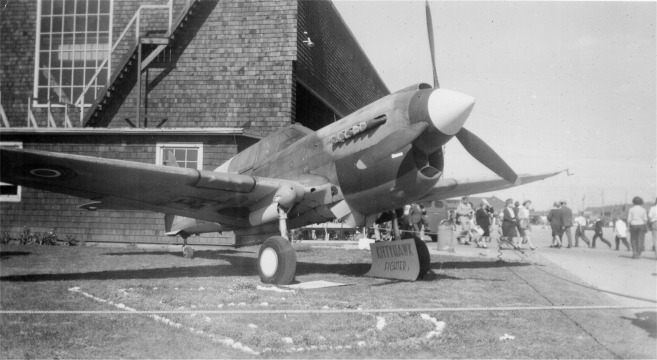 Although the Curtiss P-40 Kittyhawk was not used in the British
Commonwealth Air Training Plan, it was a significant fighter-bomber in
the Royal Canadian Air Force home defence squadrons. It and variants P-40
Warhawk and P-40 Tomahawk comprised the 13,738 aircraft built by the Curtiss-Wright
Corporation between 1939 and 1945, all in the Curtiss-Wright Corporation
plant in Buffalo, New York.
Although the Curtiss P-40 Kittyhawk was not used in the British
Commonwealth Air Training Plan, it was a significant fighter-bomber in
the Royal Canadian Air Force home defence squadrons. It and variants P-40
Warhawk and P-40 Tomahawk comprised the 13,738 aircraft built by the Curtiss-Wright
Corporation between 1939 and 1945, all in the Curtiss-Wright Corporation
plant in Buffalo, New York.
One hundred and thirty four of the Curtiss Kittlyhawks
were obtained for the RCAF through the Lend-Lease Program. They flew operations
exclusively for eight Home War Establishment Squadrons on Canada’s east
and west coasts.
The RCAF utilized the P-40 Tomahawk in four Article XV
Squadrons operating in Europe, Africa, the Mediterranean and Southeast
Asia. These squadrons were created when the four Commonwealth Countries
(Great Britain, Canada, New Zealand and Australia) signed the Riverdale
agreement to create the British Commonwealth Air Training Plan. According
to Article XV of the agreement, BCATP graduates were to be assigned to
squadrons in each of their country’s air forces or to squadrons defined
by national identity of the training graduates but under Royal Air Force
control. Under RAF control, the squadrons were given numbers in the 400
to 490 range. Canadian squadrons were numbered 400 to 449, Australian squadrons
were numbered 450 to 467 and New Zealand squadrons were numbered 485 to
490. Forty-four Canadian, 17 Australian and six New Zealand Article XV
squadrons were created during World War II. Despite the formation of 67
national squadrons, most graduates of the BCATP were assigned to British
units contrary to the conditions of Article XV.
Based on the Curtiss P-36 fighter, the prototype P-40
first flew in 1938 . Other primary users of the P-40 fighters were the
United States Army Air Corp, the Royal Australian Air Force and the Royal
Air Force. The United States cost to build one of these aircraft in 1941
was $45,000 – equivalent to $624,000 today.
The P-40 was an all-metal, single-engine, single wing
fighter and ground-attack aircraft noted for its excellent abilities in
low and mid-range altitudes. It was less successful at high-altitudes due
to engine performance issues caused mostly by an inferior fuel delivery
system. The Kittyhawk utilized two 0.5 inch guns in each wing and
had armor around the engine and cockpit
When the Japanese Navy occupied territory in the Aleutian
Islands, RCAF home defence pilots in P-40 Kittlyhawks from Canada’s 14
and 111 Squadrons worked with the United States Army Air Force to repel
the enemy. When these two squadrons returned to Canada, they were
redeployed to England without the Kittyhawks. No. 133 Squadron RCAF Patricia
Bay saw limited action intercepting Japanese balloon-bombs designed to
start fires in remote British Columbia as did members of RCAF 135 Squadron.
All of the Canadian based P-40 Kittyhawk squadrons specialized in maritime
patrol and defence over the Atlantic and Pacific Oceans.
Canadian P-40, Article
XV squadrons serving in the UK under direct command and control of
the RAF, with RAF owned aircraft.
- 403
Squadron (Tomahawk IIA and IIB, March 1941)
- 400
Squadron (Tomahawk I, IIA and IIB, April 1941–September 1942)
- 414
Squadron (Tomahawk I, IIA and IIB, August 1941–September 1942)
- 430
Squadron (Tomahawk IIA and IIB, January 1943–February 1943)
P-40 Operational Squadrons of the Home War Establishment
(HWE) (Based in Canada)
- 111
Squadron (Kittyhawk I, IV, November 1941–December 1943 and P-40K, September
1942–July 1943), Patricia Bay
- 118
Squadron (Kittyhawk I, November 1941–October 1943), Dartmouth to Alaska
- 14
Squadron (Kittyhawk I, January 1942–September 1943), Western Air Command
and Alaska
- 132
Squadron (Kittyhawk IA & III, April 1942–September 1944),
- 130
Squadron (Kittyhawk I, May 1942–October 1942),
- 163
Squadron (Kittyhawk I & III, October 1943–March 1944),
- 133
Squadron (Kittyhawk I, March 1944–July 1945) and
- 135
Squadron (Kittyhawk IV, May 1944–September 1945).
https://en.wikipedia.org/wiki/Curtiss_P-40_Warhawk
http://dictionnaire.sensagent.leparisien.fr/Article%20XV%20squadrons/en-en/
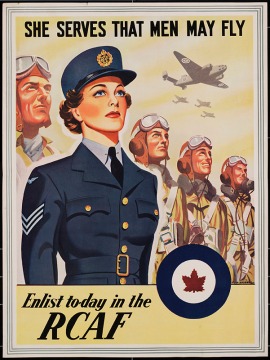
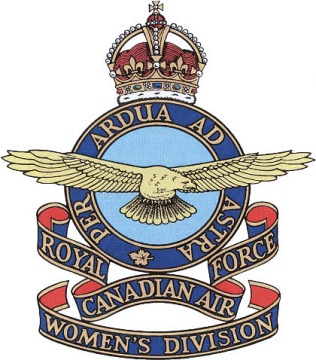
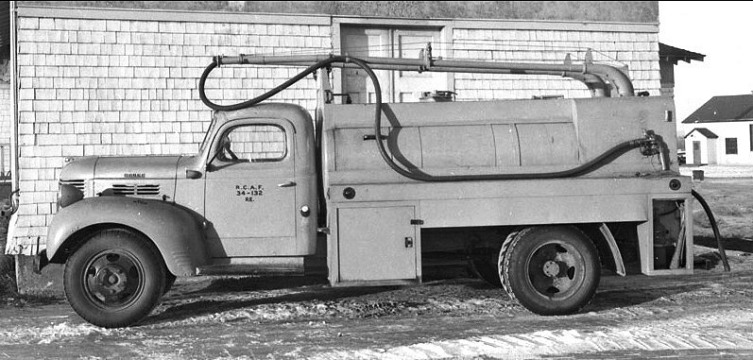
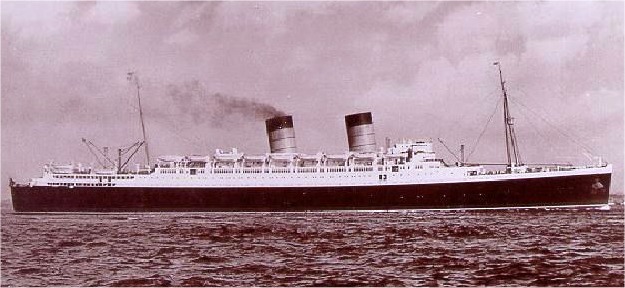
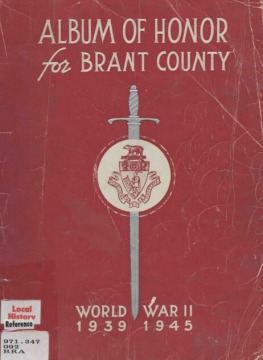
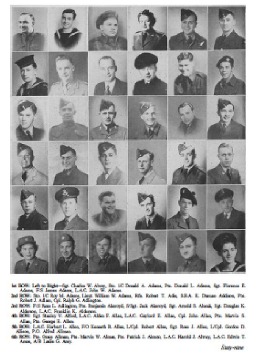
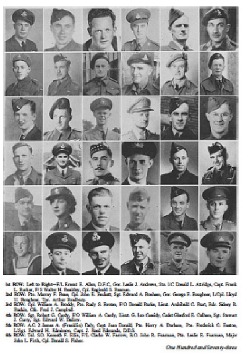
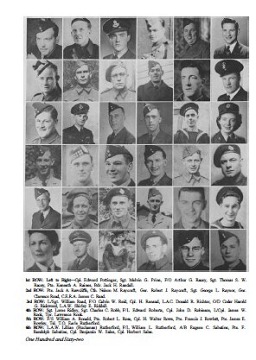
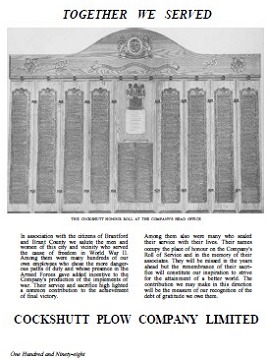 We
shall remember our Navy and our dauntless sailors who served on waters
infested by enemy submarines and surface craft of war, all carrying their
deadly freight. There was such little fanfare accompanying the Navy's job
— sometimes all the more deadly because of the monotony and the necessarily
cramped quarters — that we give those who went down to the sea in ships
a special place in our hearts and our limitless gratitude.
We
shall remember our Navy and our dauntless sailors who served on waters
infested by enemy submarines and surface craft of war, all carrying their
deadly freight. There was such little fanfare accompanying the Navy's job
— sometimes all the more deadly because of the monotony and the necessarily
cramped quarters — that we give those who went down to the sea in ships
a special place in our hearts and our limitless gratitude.
